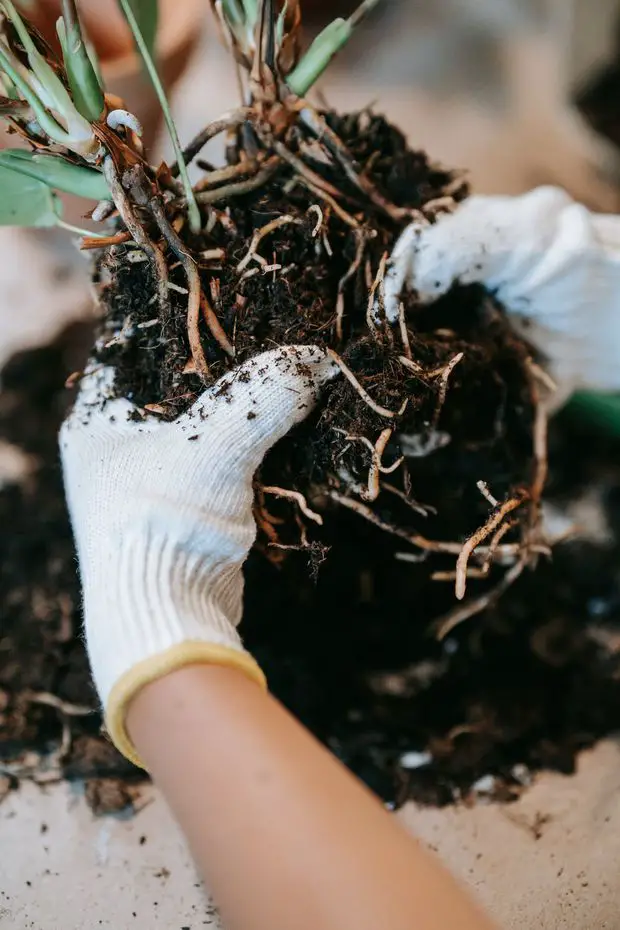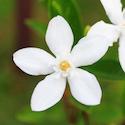From indoor to outdoor gardens, one of the most common diseases that can spoil our summer thriving jasmines are fungi infections. Plant fungus is a common grief for all of us jasmine lovers, but don’t panic! as fungal diseases, although looking nasty, are not fatal to our jasmine plants. Below in this post, we will dive a bit deeper into the easy enough strategies to cope with these infections and treat them. Fungal infections primarily occur and develop in the leaves but some species also infect the flower buds and stems of the plant. Fungal pathogens are avid parasites, able to live for long periods of time in the soil, to then strike up on new plants and thriving during pruning periods to invade the plants.
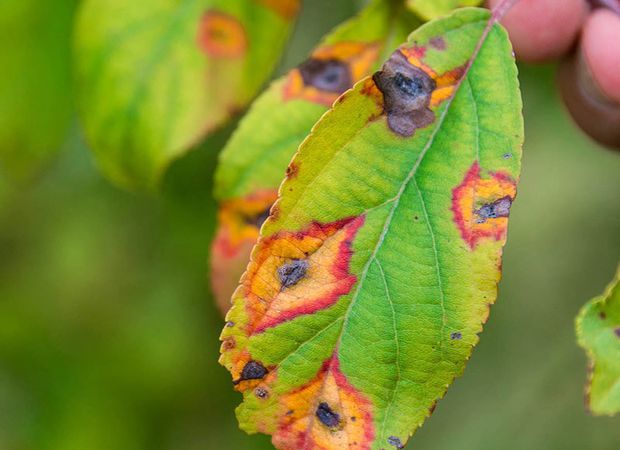
Fungi life cycle involves the production of spores, which will be carried through plant to plant via agents such as the wind, water or insects to then begin their infective process. One of the essential reasons, as to why Jasmine plants are so susceptible to fungal infections, is because, in order for the fungi spores, to be infectious, adequate moisture, wet and warm air temperature are crucial. And as we have a learnt from previous blog posts, Jasmine plant thrives in moist, humid and warm environmental conditions, so they are very prone to these diseases. Once the fungal infection becomes active, these parasites, will exploit and take all the energy out the plant, leading our jasmine plant to be weaker and prone to more diseases pest bugs. When our Jasmine plant is infected by nasty fungi, common clinical signs of this invasion will display in the forms of rusts, wilting, scabs, mouldy powdery and rotted tissue appearing either in the leaves, stems or flower buds. Therefore, learning how to protect our jasmine plants from fungal infections, how to make your own fungicides and develop the appropriate culture techniques, are the key to succeed in making our Jasmine plants thrive! Below, we dive in to some of the most common types of fungal infections in Jasmine plants, how to prevent and treat them.
How to treat fungus on confederate jasmine?
The treatments to fungal diseases in Star Jasmine will be different and specific to the type of fungal infections happening in our plant. However, there are common treatments to all of them that englobe a mixture of chemical fungicides, such as, copper or mancozeb/carbendazim based and organic fungicides, some of them easy enough to make at home involving simple ingredients like baking soda, spices and herbal tea weeds.
How to make homemade organic fungicide sprays.
1-To avoid fungal infections when we are planting our Star Jasmine seeds, simply make a solution with one tea bag of chamomile in a quarter of water, to then, water our seeds, as chamomile contains sulphur, that will kill early on fungi that might live in the soil.
2- To boost the growth of commensal beneficial fungi (this is to compete with the pathogenic fungi populations), we can easily make a mix of a half cup of cornmeal with bark mulch. This mixture will be sprinkled around our Jasmine Plant to promote the growth of commensal fungi and provide extra nutrients to our Star Jasmine!
3- To help decreasing the fungi burden in the leaves, it helps to use ground cinnamon and rubbing it around the affected mouldy areas. Do not use too. much, otherwise it will burn the leaves.
4- To help killing the spores of the fungal specie attacking our Star Jasmine, we can use a solution made with milk! A third of a cup of milk mixed with three cups of water, can get you an excellent organic fungicidal mixture, where you will be brushing or spraying the leaves with, so that spores can’t anchor in the leaves. This particularly efficient in powdery mildew infection.
5- As we cover below in this post, black mold or sooty mold, is a common and nasty fungal infection. If we use a mixture of a tea spoon of baking soda, swirled with a quart of water and two tea spoons of liquid mild soap, you got yourself an amazing organic treatment to spray our Star Jasmine leaves (both on the upper side and underside) and will mitigate the black spot infection. Big warning here is to be very cautious on how much if this mixture you use, as too much of it during really hot and sunni days will burn the foliage of your plant.
What are the types of fungal infections in Star Jasmine?
Sooty Mold
Sooty mold is a very common fungal disease which Star jasmines are prone to, involving different fungi species of the Scorias, Fumago or Capnodium family. It is a black mould found in most of Jasmine species but particularly in Confederate Jasmine plants, as a consequence of the sugary material left in the flowers and stems by insects, such as, aphids, mealybugs and whiteflies that thrive on sucking up the jasmine sap. These nasty insects (a pest on itself in our Star Jasmine) feed up on the sap of the plant until full and excreting the excess of the sap that can be digested, called honeydew. This honeydew will drop off in the leaves, stems and flower buds around promoting the sooty mold, to develop and subsequently, our jasmine leaves will start looking with black spots all over.
If heavy burden of sooty mold in Jasmine leaves, the light won’t be able to penetrate in the leaf, as the photosynthesis process can’t be carried out, and therefore the nutrients won’t reach the leaves making them turn yellow and eventually the plant will die.
Treatment for sooty mold in Confederate Jasmine.
Sooty mold, although being quite infective, it is not fatal to our Jasmine plant. Usually, the rain will eventually clean up the plant form these nasty fungi, or at least it will dilute the burden.
You can also rinse your Star Jasmine plant thoroughly with mild soapy water sprays. Inspect the leaves regularly and frequently to ensure our plant is not covered by insects.
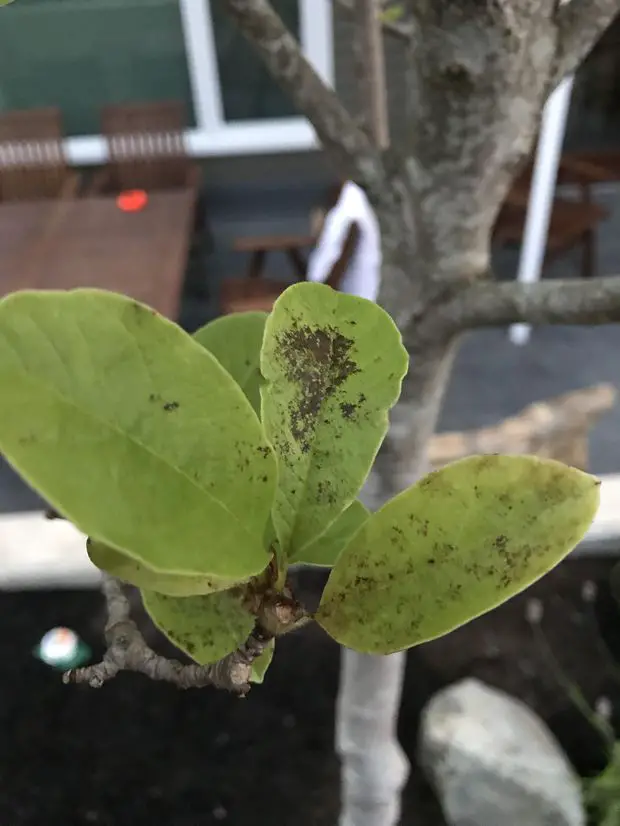
Downy mildew
Plasmopara viticol, aka, Downy mildews, compiles all types of oomycete microbes or what’s called fungus-like organisms. These types of organisms, viciously attack the leaves and the upper parts of our Star Jasmine plant. Downy mildews absolutely thrive in cool, damp and moist conditions, unlike the rest of the fungal conditions which love warm and humid environmental conditions. They tend to infect young and and distress Jasmine plants, so young jasmine shrubs will be the perfect prey for these microorganisms. When Star Jasmine plants get infected by downy mildew, the leaves will slowly but progressive start turn yellow with discoloured patches which will be found on the underside of the leaf in combination with areas of white and greyish of other fungal growth. This will ultimately lead to the death of the stems and the leaves will turn purple. If the flower buds are infected, they will simply start getting brown and eventually will drop off. These guys are not limited to infect Jasmine plants but also being quite popular offenders in other edible crips such as lettuce, cauliflowers or onions. To help treating and fixing this process, it is essential to remove and destroy all infected leaves and other parts of the plants as quickly as possible, as the clinical symptoms are seen.
This includes, some healthy parts of the plants and soil in the surrounding to help ensuring all infected agents are destroyed. As we have learnt earlier, these micro-organisms love a cool and moist environment, so, it is really important that we ensure a good air circulation in the plant, as well as, proper watering practises early int he morning, to allow the warmth of the day to dry up the excess moisture through the day. When this infection occurs, chemical fungicides are required at 5-7-day intervals. These chemical fungicides involve the ones which main ingredients are mancozeb or chlorothalonil.
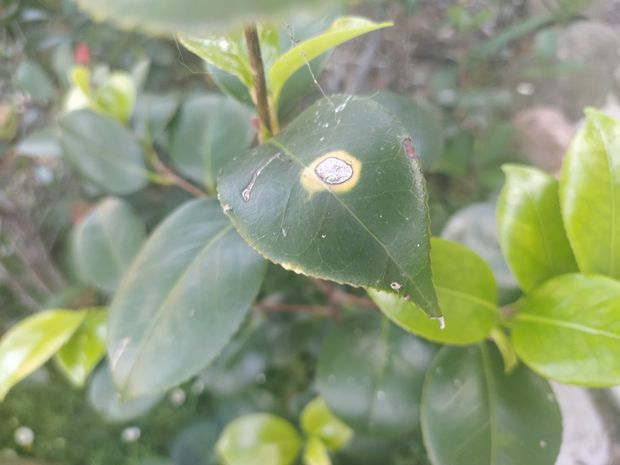
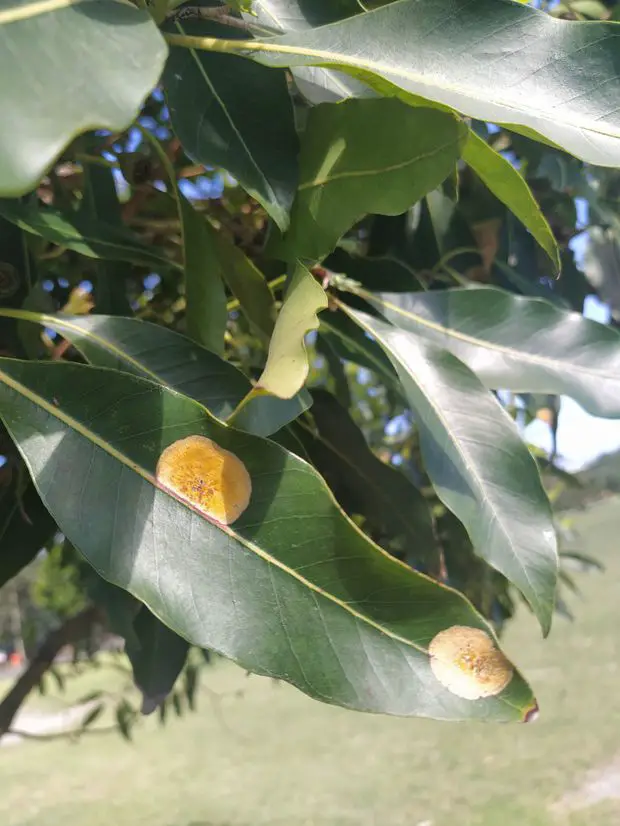
Powdery mildew
Powdery mildew is a very common fungal disease caused by a group of very specialised fungal species belonging to the genus of Erysiphe, Microsphaera, Phyllactinia, Podosphaera, Sphaerotheca and Uncinula. These fungi are very contagious and not only affect our beautiful Confederate Jasmine plants, but also it is a common disease on a wide range of other plants, such as gardenias and lilies. Whilst powdery mildew is a nasty fungal infection in Star Jasmine, unlike other fungi diseases, it is specific of one plant, meaning that if you had other plants around your Star Jasmine, it won’t spread to them and vice-versa. As mentioned above, there are numerous types of powdery mildew, depending on the fungi specie involved, but the common factor of this infection is, that it occurs during the end of spring, early summer and autumn times, where the weather conditions are drier in the soil but moist and damp in the upper parts of the plant, as the rust spores thrive and flourish on humidity. A closer examination in the upper part of the plant, such as, the leaves or flower petals, it is easy to spot that these areas are badly affected, both on the topside and underside of the leaves with a bad white and/or pale brown dusty coat on them. When the leaves and flower petals are affected by these fungi, it is common clinical symptom to see that these leaves will start turning to a pale yellow tone and they will progressively start getting distorted. In the worst case scenario, this infection will promote the fall of the leaves and stems leading to a slow in the growth of the [plant and when the leaves fall off then a Shot hole effect can happen.
How do you treat powdery mildew, aka, white fungus on Jasmine?
There are different ways in which we can prevent and treat powdery mildew infections, such as, in the early spring, as soon as the infection symptoms are visible, all the leaves should be removed. This process should be dine with care not to agitate the leaves and make the spores fly away and end up in another part of the plant or new plant which will get infected. A good way to ensure the infected material is destroyed, is to use it as compost after being incubated in a hot compost system. Practising good culture techniques, such as, proper irrigation methods, maintaining the right moisture around the rooting system of the plant by mulching plants early in the spring to hep with the water retention for the rest of the year. A really great tip here is not to pour water over the Star Jasmine whilst watering the plant, instead do it from the soil angle. This is due to the fact that, the Powdery mildew fungus spores will also survive in the water and wind, so if in the watering process, you produce too many splashes, then the odds of other plants around getting infected are really high. Once the prevention techniques have been stablished, we also need to know how to treat our Star jasmine from these nasty infections with the aid of selective and specific chemical fungicides, which main ingredients are Triticonzaole or Sulfur dust spray is highly effective but should not be applied in hot weather.
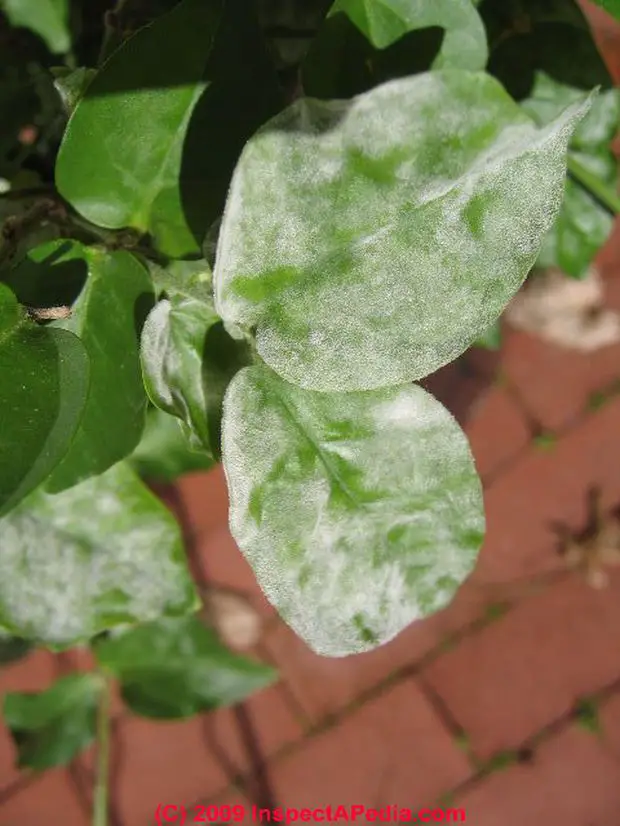
Cercospora Leaf Spot
Cercospora leaf spot, is a very common fungal disease caused by the fungus Cercospora beticola. The visible clinical symptoms of this infection are brown and red tone circular spots in the laves of our Jasmine plants. These fungi absolutely flourish and warm and wet conditions making its peak of infections opportunities during the summer blooming season. As the wet season advances, the spots become more numerous and more irregular. This will lead to the entire leaves to turn yellow, wither and ultimately will fall off. The way we treat this fungal infection is by spraying the flower buds with a copper or mancozeb/carbendazim based chemical fungicides. This treatment should be applied during three weeks every 5 days when the infection is well established in our Jasmine plant. The way we can mitigate this infection to eventually kill our plant, is by removing the ill areas of the plant and burning them , do not compost them. Once the infected parts of the plant have been removed, it is of good practise to use a thick layer of mulch to cover the soil where our jasmine is planted. This will help reducing weeds and garden debris, preventing the disease pathogen from splashing back up onto the leaves.
Blight
Early blight is another common fungal disease in Star Jasmine plants caused by the fungus specie Alternaria solani. The most significant symptoms of Blight disease are discolouration of the leaves to a brown tone from the edges of the leaves inwards. Often times, it comes accompanied by dryness and curling. It can also infect the stems and flowers of the Jasmine plant and when this happens usually the fate of the plant is not certain. We have to be quick when it comes mitigating this disease, as it is really contagious and unlike the other fungal indications described above early blight can occur any time throughout the growing season and also it is very easily transmittable through splashing rain, irrigation, insects and garden tools and quickly infect the rest of the plant and other plants around our Star Jasmine plant, particularly when environmental conditions are really warm and humid.
How to treat Early blight fungal infection in Confederate Jasmine
The treatment of Early blight involve proper and early pruning of our Start Jasmine early in the growing season to help improving the air circulation in the plant, this will reduce fugal issues. Next, it is crucial to sterilise the pruning shears with bleach diluted in water after each cut. The follow up steps, compile keeping the soil covering our Star Jasmine free of of weeds and garden debris. For this, don’t forget to add a layer of organic compost to prevent the fungal spores to fly around and end up in the upper parts of the plants again. If the plants remain too wet throughout the day and night, the leaves and flowers will keep growing that fungi so adding systems for controlled irrigating and soaker hoses, this will aid to boost the foliage to dry appropriately. A very good tip that has given me very good results, are to apply copper oxychloride-based fungicides for two weeks every 4 days, if you see that the weather forecast predicts a couple of days of rain or during the wet season. If the infections is well established in the plant, then you will need to treat it every 7 days for three weeks or so.
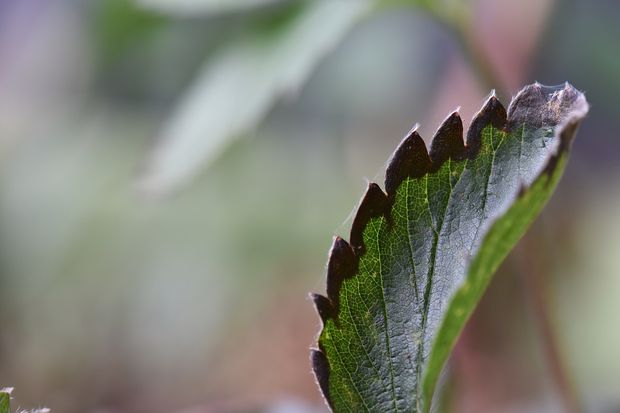
Wilt
Wilts in plants are a disease that occurs as the result of a water supply. As we know, our Star jasmine needs a constant controlled water supply for it to thrive. When this supply stops (either because you forget to water your plant, the soil dries out for too long…), the plants rapidly starts shutting down, drying out and wilting. In contrast, overwatering our Jasmine plant, also leads our Jasmine to wilt, as the soil is flooded and the roots suffocate and wilts.
When the wilts come from a Verticillium or Phytophthora wilt pathogen, then these fungi will go into the water transported vessels of the plant and they will kill the roots, as the water will be clogged up in this vessels without movement. The ultimate consequence will be that the roots will rot and the plant will eventually die.
How to treat wilt fungal infection
As we were mentioning above, if the wilts developments is caused but watering problems, then carefully re water your Jasmine Plant, so that, the roots can carefully star reviving, however don’t over do it, as that will also contribute to this rotting process. If it is due to fungal pathogens, then carefully prunes all the affected brittled stems and and give your Star jasmine a good liquid feed and foliage feed with seaweed tonic sprays, to help boosting its energy. Chemical treatment are not really available for this kind of infection. To wrap it all up! being aware of al types of fungal infection in Jasmine plants and the possible treatments available to fix these diseases is crucial for the future survival of our Star Jasmine. Sometimes the treatments are simple home made solutions that can go a long way, cheap and really effective.
